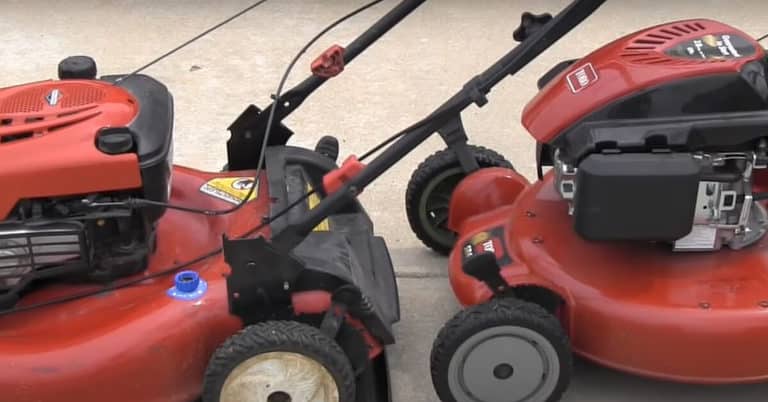How Long Does It Take to Replace a Sewer Line
Replacing a sewer line can be like walking through a dark, winding tunnel with no end. You don’t know how long it will take and may not even know where to begin. The truth is that the process of replacing a sewer line varies depending on a few factors – the type of damage, age of pipes, and location all affect the timeline. But, one thing that remains constant is that this project needs professional help.
In this article, we’ll explore exactly how long it takes to replace a sewer line, the costs associated with such an endeavor, and some alternative solutions if replacement isn’t necessary. (Read Why Does My House Smell Like Paint)
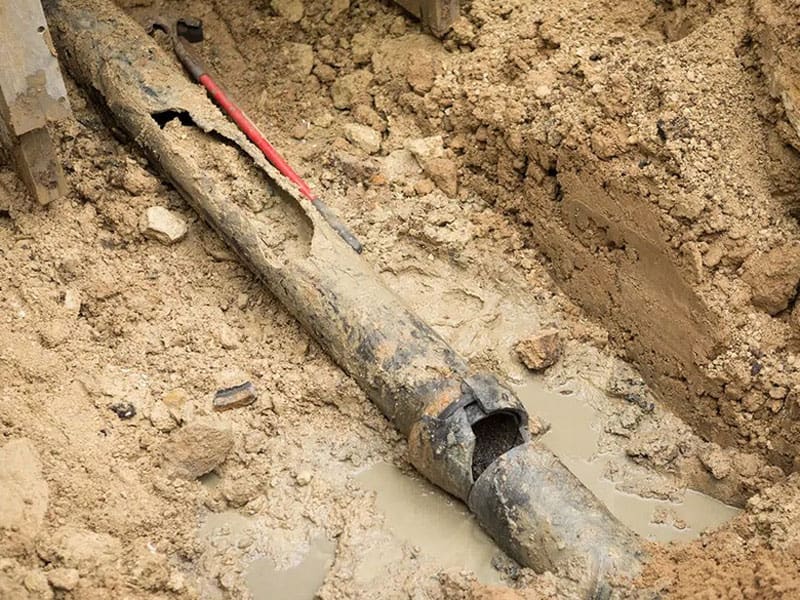
What is a Sewer Line, and When Does It Need to Be Replaced?
If you’re noticing slow drains and water backups in your home, it may be time to consider replacing your sewer line. Common causes of sewer line damage include:
- Tree roots breaking through pipes
- Corrosion causing structural failure
- Cracked or separated pipe connections
- Improper slope or pitch of the pipe
- Failed older clay or Orangeburg pipes
When deciding when to replace a sewer line, factors like the location of the clog, depth and ground conditions, age of pipes, and material of pipes should all be considered. Don’t let a broken sewer line go unchecked. Replace it quickly to ensure minimal disruption to your home’s plumbing system.
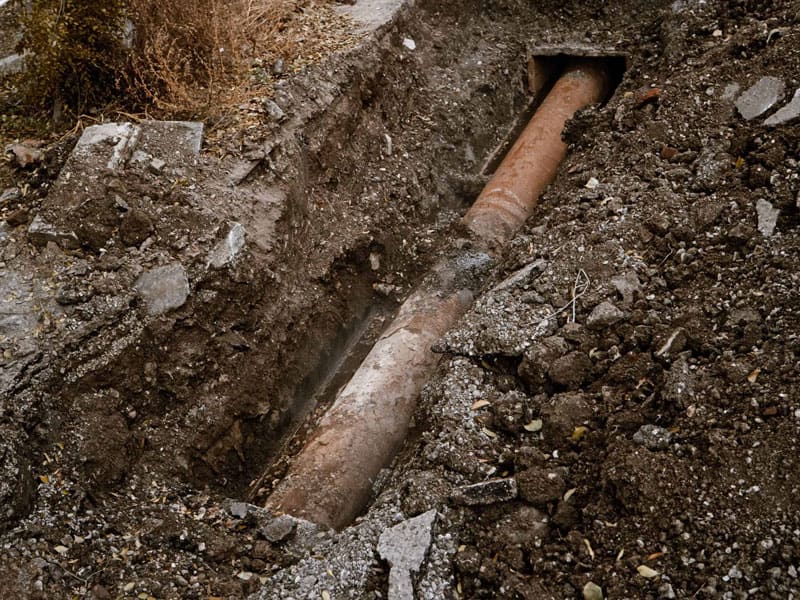
Signs that a sewer line needs to be replaced
When it comes to replacing a sewer line, clear signs indicate when it’s time to call in a professional. Roots growing through pipes, corrosion, and cracked connections can damage your sewer line. If you’re having problems with your sewer line, you may need to replace your sewer pipe rather than repair it. Don’t kick the can down the road – if you suspect your sewer line may require replacing, consult a professional immediately for an assessment.
Causes of sewer line damage
Various factors, such as roots and corrosion, can cause sewer line damage.
Tree roots can break through pipes, which can lead to costly repairs.
Corrosion can cause structural failures, especially in older clay or Orangeburg pipes prone to breaking.
Connections may become cracked, separated, hollow, or skewed due to improper slope or pitch of the pipe.
Traditional excavation repair methods or newer trenchless techniques like Pipe Lining and Pipe Bursting technologies can replace the sewer line for quick repair and replacement.
When to consider replacing a sewer line
Several signs indicate it may be necessary when considering whether or not to replace a sewer line. These signs include slow-draining water, gurgling drains, backed-up toilets or sinks, sewage odors, wet spots around the yard, and rodent infestations. If any of these issues are present, contacting a professional to inspect for damage is essential. Sewer line replacement can be expensive, but it is often more cost-effective than repair over time and can help avoid future problems related to poor drainage or leaking pipes. It is essential to hire an experienced contractor who can complete the job quickly and correctly, as the replacement process can take anywhere from 1 to 3 days, depending on the location and type of damage.
Factors that affect the need for sewer line replacement
Several factors can affect the need for sewer line replacement. These include tree roots breaking through pipes, corrosion causing structural failure, and failed older clay or Orangeburg pipes. When determining the time for repair, it is essential to consider the location of the clog, depth, and ground conditions, as well as the age and material of the pipes.
Some other considerations include the time it takes for sewer line replacement, which typically ranges from 1-3 days. The repair method needed, whether it involves digging or using a backhoe, can also impact the overall process. Finally, the total sewer line repair cost will depend on the job’s complexity.
It is essential to carefully evaluate these factors to determine if sewer line replacement is necessary and plan accordingly for the repair process. (Learn How To Tell If Dehumidifier Is Working)

How Long Does the Sewer Line Replacement Process Take?
Depending on various factors, replacing a sewer line can take anywhere from one day to several days. These factors include the age of the pipe, the type and extent of damage, access to the line, and the materials used. It’s essential to consider these factors because they can affect the duration of the replacement process. For example, if the pipe is old and extensively damaged, it may take longer to replace. Additionally, the method used for replacement can also impact the timeline. Methods like pipe bursting may take longer than quicker fixes like pipe relining. Understanding these details before starting any repairs is crucial to ensure an efficient process. By doing so, you can avoid potential delays that could prolong the duration of your repair.
Average time required for sewer line replacement
On average, sewer line replacements take 1-3 days. However, a variety of factors can impact this timeline.
Traditional sewer line replacement jobs involve excavation and pipe installation. Location, access, and age of the pipes are all considerations that play a role in determining how long it will take to complete the job.
Professionals typically use advanced tools to keep costs down and work quickly. However, complicated repairs or materials may add time and cost to the project.
Ultimately, the sewer line replacement job costs should be weighed against its length of time before deciding upon a contractor.
Factors that impact the timeline
The journey of replacing a sewer line can be unpredictable due to various factors that significantly impact the timeline. These factors include the length of the pipe, traditional sewer repair methods, access to the sewer line, and local regulations. The tube size is an essential factor to consider, as it directly affects the time required for replacement. Longer tubes may take more time to replace compared to shorter ones.
Traditional sewer repair methods can also influence the timeline. Some procedures, such as trenchless sewer repair, are faster and less disruptive than conventional dig-and-replace methods. Access to the sewer line is another factor that can impact the timeline. If the sewer line is located in a hard-to-reach area or obstructed by other structures, it may take longer to access and replace the cable.
Local regulations also play a role in the timeline of sewer line replacement. Permitting processes and inspections required by local authorities can add additional time to the project. Considering these variables carefully is crucial in making informed decisions about your sewer line replacement project. Doing so can minimize the potential for unexpected delays and additional sewer line repair costs.
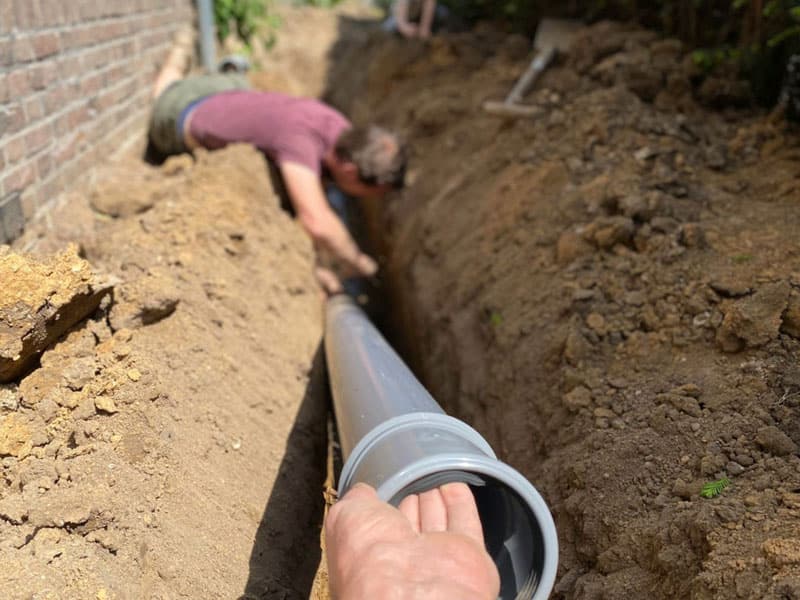
Steps involved in the sewer line replacement process
To successfully replace a sewer line, there are several steps involved in the process:
- Plan: Planning and determining if trenchless or traditional methods should be used before starting the sewer line replacement is crucial. This decision will depend on factors such as the condition of the existing pipes, the extent of the damage, and the accessibility of the sewer line.
- Prepare your home: PPreparing your home for the complex process is essential before the replacement before the replacement. This may involve clearing any obstacles or debris that could hinder the work, ensuring that the area is easily accessible for the technicians, and making arrangements for any necessary permits or approvals.
- Choose the correct method: If trenchless sewer line replacement suits your situation, it can be a less invasive procedure requiring minimal excavation. However, if you have cast iron sewer pipes, more work may be needed as these pipes are heavy and difficult to install. In such cases, it is advisable to seek assistance from local sewer repair services.
- Repair or replace pipes: Depending on the condition of the existing sewer pipes, repair or replacement may be necessary. Sewer pipe repair may be required if there is corrosion or other damage caused by roots or other factors. In some cases, it may be more cost-effective and efficient to install new pipes instead.
Following these steps and ensuring proper preparation and planning will give you all the necessary tools for a successful sewer line replacement project.
Comparison of different replacement methods and their time requirements
Now that you know the steps in replacing a sewer line, it’s essential to understand the other replacement methods and their time requirements. Here are four points to consider when it comes to replacing your sewer line:
- The type of method used for replacement can affect how long it takes.
- Different materials require varying amounts of time if they need to be replaced.
- If a sewer line runs under your yard, repair work might be quicker than if it runs under a street.
- Hiring a professional is usually worth the cost for proper and timely replacement.
No matter which method you choose to replace your sewer line, keep an eye on the time requirements so, you can get back up and running quickly! (Learn How Long Does Tile Mortar Take To Dry)
Common challenges that can extend the duration of the replacement
Unfortunately, there are common challenges that can extend the duration of sewer line replacement. These challenges include discovering a collapsed pipe during excavation, which requires additional time to address. Additionally, damaged sections of the sewer pipe may need to be replaced due to issues like tree roots or corrosion. This process can also contribute to delays. Another factor that can add time to the project is the need to hire a contractor for sewer repair, which often requires obtaining additional permits and undergoing inspections. It is essential to consider all of these factors when calculating the expected duration of a sewer line replacement.
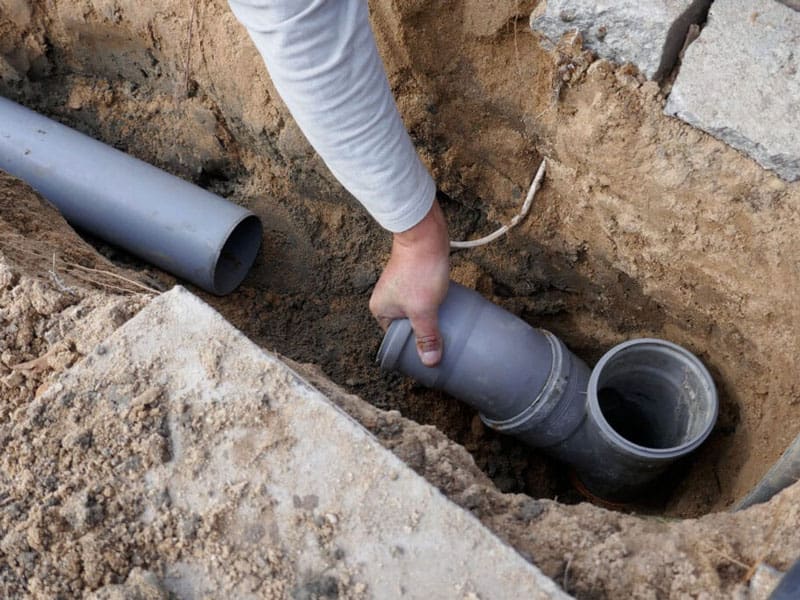
What are the Costs Associated with Sewer Line Replacement?
Replacing a sewer line is not only time-consuming but can also be costly. The replacement cost depends on several factors like the type and material of pipe, location, size, length, etc. The average cost to replace a sewer line can range from $1,500 to more than $4,000, depending on the job’s complexity.
It’s always recommended to obtain multiple quotes before proceeding with any repair or replacement to find the most cost-effective solution for your needs. Additionally, homeowners should consider some potential cost-saving measures when replacing their sewer lines.
Factors influencing the cost of sewer line replacement
When considering the cost of replacing a sewer line, it is essential to consider several factors. One such factor is the type of sewer line being replaced. Cast Iron Sewer Lines, for instance, often require specialized tools and more labor-intensive processes than standard PVC pipes.
In addition to the type of sewer line, a complete Sewer Line Replacement Project may involve other expenses, such as excavating and trenching. These processes can add to the overall cost of the replacement. Furthermore, obtaining permits from local authorities is often necessary for a sewer line replacement. This additional cost should be considered when budgeting for the project.
Considering these factors, hiring a professional Sewer Line Repair Solution is often recommended for significant repairs or replacements. Professional services tend to be more cost-effective compared to traditional methods. However, a do-it-yourself (DIY) approach may be an option for smaller jobs. It is essential to carefully evaluate the feasibility of this approach and consider consulting with a professional Sewer Line Replacement service before proceeding with any work.
The average cost of the sewer line replacement
The average cost of replacing a sewer line can vary greatly, depending on the size of the project and the materials needed. For instance, a homeowner in NYC recently reported spending about $6k for total replacement, including labor and materials. This is an example of what homeowners can expect to pay when replacing their sewer lines.
The average price for homeowners across the US will depend on several factors, like local labor costs and the type of material used. It’s essential to inspect your sewer before deciding how much you should spend on replacing it, as this will help you find exactly what needs to be done.
Cost comparison between different replacement options
Comparing replacement options can save you time and money when fixing a broken sewer line. Consider the cost per foot of pipe, sewer line replacement method, repair a sewer line, and replace the sewer line for different materials.
Importance of obtaining multiple quotes
Getting multiple quotes for a broken sewer line repair can be a smart move, saving you time and money. Knowing the length of the line and the type of materials used is essential to replace your sewer line correctly. When getting quotes, ask questions about sewer lines and inquire about any additional fees that may apply. Doing this helps you compare costs accurately and decide which option fits your budget best.
Understanding how much sewer line replacement costs can help you make an informed decision regarding repairs.
Potential cost-saving measures
Savvy homeowners can use cost-saving measures when repairing a broken sewer line. Two standard options that may be cheaper than running an entirely new pipe from the home to the city central are trenchless sewer lines and repair or replacement close to the city main. Researching familiar city sewer pipe materials, their cost, and how long it takes to replace a sewer line can help you make an informed decision.
Other alternatives, such as relining existing pipes or using larger diameter pipes, may also reduce costs while ensuring your plumbing is up-to-date. (Learn How To Stop Water Pooling On Decking)
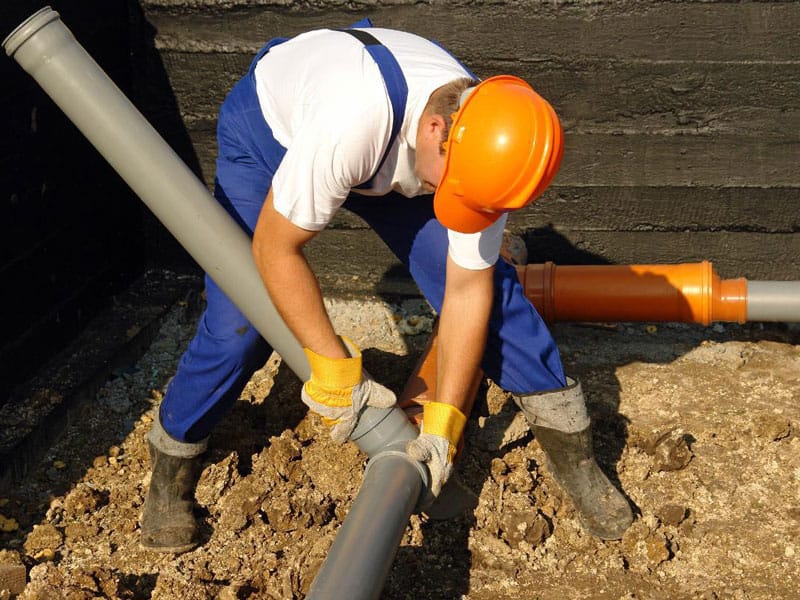
Do I Need to Hire a Professional for Sewer Line Replacement?
Replacing a sewer line can be daunting, but it doesn’t have to be. Hiring a professional for your sewer line replacement has advantages, such as the assurance of reliable work and the knowledge that they have the right tools and experience to do the job correctly. But if you’re confident in your DIY abilities, you may want to consider attempting a replacement yourself – make sure you understand all potential risks involved.
When selecting a professional service for your sewer line replacement needs, ask them questions regarding their experience, rates, warranties, and guarantees. Doing so can ensure you get quality work at an affordable price.
The advantages of professional sewer line replacement
There are several advantages to hiring a professional for sewer line replacement. First and foremost, professionals have the experience and expertise to ensure the job is done quickly and efficiently without costly mistakes. They know how to properly excavate the area to ensure the new sewer lines are installed correctly. Additionally, professionals can access advanced tools and equipment that make the replacement process much faster and more efficient. This means less disruption to your property and a quicker resolution to your sewer line issues.
Another advantage of hiring a professional is that it is often more cost-effective in the long run. While DIY repairs or patch-ups may seem cheaper initially, they can often lead to more problems and cost you more in the long run.
Finally, professionals have expert knowledge regarding sewer line replacement, repair, and installation. This means they can provide valuable advice and guidance to help you avoid future problems with your sewer system. By hiring a professional, you can know that the job will be done right the first time and that your sewer system will be in good hands.
When DIY sewer line replacement may be a feasible option
If you’re feeling adventurous, DIY sewer line replacement can be an enriching and satisfying experience! Ja Plumbing Heating Cooling offers guidance to help you through the process. Depending on where it’s located, the sewer line break may require all-out excavation of your yard or street, Sewer line replacement involves digging a trench, removing the old pipe, and installing new piping.
You’ll then need to backfill the area and restore any landscaping disturbed during the sewer repair process. With enough research and determination, DIY sewer line replacement can be done safely and correctly.
Risks associated with inexperienced DIY replacements
Attempting DIY sewer line replacement without proper knowledge and experience can be costly and potentially disastrous. Without the right tools, techniques, and expertise, issues such as poor pipe connections, shoddy repairs, inadequate slope or pitch, improperly fitted seals, and damage to other lines or underground systems can arise.
Experienced professionals should always handle sewer line replacement to avoid these risks and ensure proper pipe replacement.
How to choose a reliable sewer line replacement service
Choosing a reliable sewer line replacement service is critical to navigating the murky depths of underground plumbing so you don’t get caught in a flood of problems. The right approach to sewer line repair and replacement requires an experienced service technician who knows common pipe materials and their availability.
Don’t take chances with your water lines; only rely on certified experts with years of experience. Ask for references, read reviews, and trust your gut when selecting the best team.
Questions to ask a potential sewer line replacement professional
When selecting a sewer line replacement professional, it’s crucial to ask the right questions to ensure you receive the best service. Here are some essential questions to consider:
- What is your experience with broken sewer pipe repairs?
- What type of repair method do you typically use?
- Do you provide sewer line backup or inspection services?
- Are there any additional services you offer related to sewer line replacement?
- Can you provide specific examples of the types of damage you can fix?
- How long does it typically take for you to complete a sewer line replacement job?
- Can you provide a written quote for the work?
- Is all of your work guaranteed?
Asking these questions will help you make an informed decision and ensure you choose the right professional for your sewer line replacement needs.
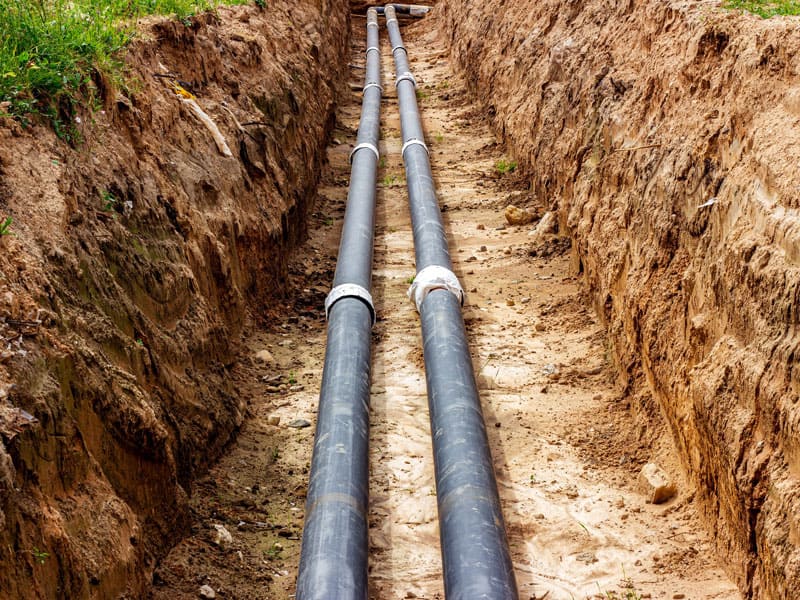
What are the Alternatives to Traditional Sewer Line Replacement?
If you’re considering replacing your sewer line, trenchless sewer line replacement is one of the best alternatives. This method offers many benefits over traditional methods. It has a faster installation time, reduced property damage, and lower costs. However, it’s essential to compare the two plans and consider all factors before deciding which option is right for you.
A trenchless replacement has limitations that should be considered when selecting the best solution for your needs.
Trenchless sewer line replacement
Trenchless sewer line replacement is a ‘lifesaver’ for those looking to replace their lines quickly and efficiently! It involves replacing iron sewer pipes from one point to another without digging. This can prevent backups of wastewater and the need to return an old line. The process usually takes a day or two, compared to several days with traditional methods, which involve digging up the yard or street.
With trenchless sewer line replacement, you do the job quickly without worrying about long-term damage in your yard or driveway.
Benefits of the trenchless sewer line replacement
If your sewer line may need repair or replacement, a trenchless sewer line replacement can provide the quality and longevity you need. This method of replacing an entire sewer line requires minimal disruption to your property and offers several benefits compared to traditional excavation. Long does it take? Depending on the project’s scope, most trenchless replacements can be completed in 1-3 days. Let’s see what else this cost-effective solution has to offer:
| Benefits | Drawbacks |
|---|---|
| Minimal disruption | Expensive upfront costs |
| Quicker installation time | Requires special equipment & technicians |
| Less labor intensive than traditional excavation methods | Limits on pipe size & material type |
| Less damage to landscaping & structures | Risk of unknown underground obstructions like rocks or roots not being detected during the assessment phase |
Comparison between traditional and trenchless methods
When comparing traditional and trenchless methods, it becomes clear that the latter often provides a quicker installation time and causes less disruption to your property. Trenchless sewer line replacement utilizes existing access points to maintain wastewater flow with minimal excavation. This method is suitable for replacing ABS or clay sewer pipes in areas with hard-to-reach locations.
On the other hand, for primary sewer line replacements, traditional methods involve digging trenches along the length of the pipe. This process can result in significant disruption to landscaping or hardscapes. In contrast, trenchless installation only requires two minor access points at either end of the new pipe. This reduction in labor costs and faster installation time make trenchless methods more efficient than traditional methods.
Considerations for selecting the correct replacement method
Several factors must be considered when choosing the correct replacement method for your sewer lineseveral factors must be considered costs installation time. Some important considerations are:
- The ability to fix a sewer pipe within the old pipe
- The complexity of clearing a sewer line clog
- The length of the section of pipe needing repair
- The amount of excavation required for a broken sewer line
- Advanced tools that can minimize labor and maximize efficiency.
Each factor determines the most suitable replacement method for your sewer line.
Limitations of the trenchless sewer line replacement
Now let’s talk about the limitations of trenchless sewer line replacement. This method may not always be suitable depending on the condition of your pipes, yard, and surrounding environment. For instance, if there are pools of water in your yard or damage to the grass from a previous repair, this could extend the actual time estimate for replacement.
Furthermore, you should also consider other factors, such as where you live and what type of pipe needs to be replaced; these will determine whether trenchless is an appropriate solution for your sewer line problem. Ultimately, the need for a sewer line replacement will depend on many variables that must be considered.
Conclusion
Replacing a sewer line can be time-consuming and costly, but it doesn’t have to be! An experienced professional can help you get the job done quickly and correctly. On average, residential sewer line replacements take 1-3 days to complete, although some may take up to 5 days or longer.
With the right equipment and know-how, an experienced pro will install your new line in no time – often saving you 50% of the cost compared to traditional replacement methods. So don’t delay – contact an experienced professional today!






